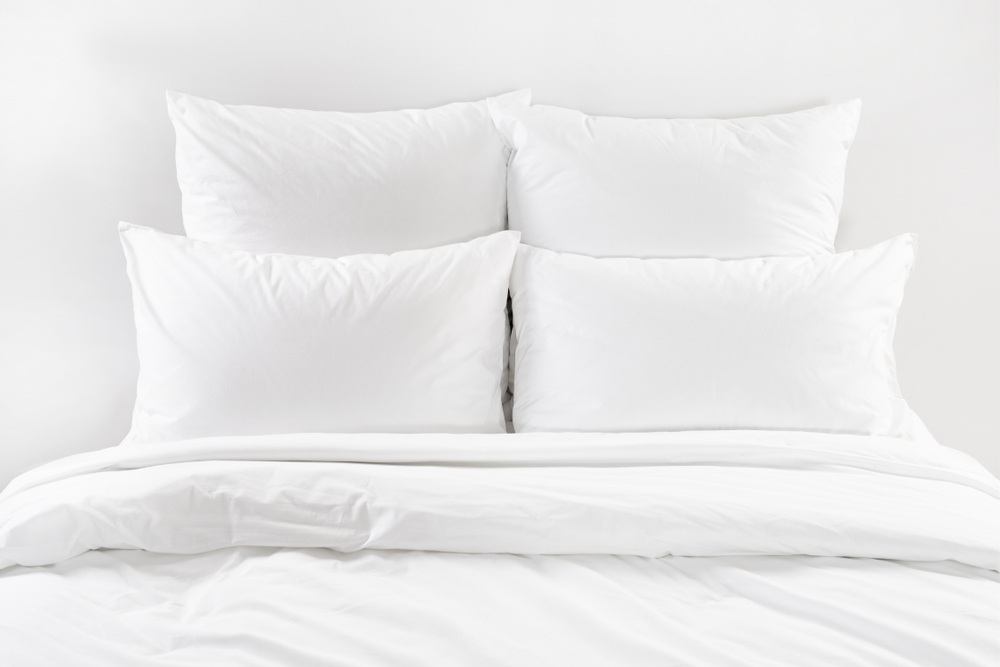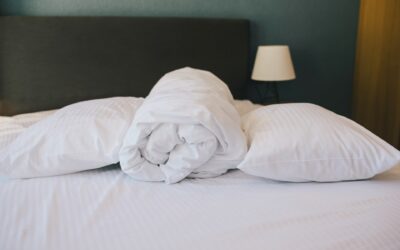Your content goes here. Edit or remove this text inline or in the module Content settings. You can also style every aspect of this content in the module Design settings and even apply custom CSS to this text in the module Advanced settings.aYou just swapped out your comforter for a freshly cleaned one, and it feels like heaven—soft, fluffy, and spotless. It’s the kind of fresh start that makes your bed feel like a five-star escape. Then, suddenly, a splash of coffee during your lazy morning scroll in bed, a sneaky dollop of ketchup from last night’s fries, or even a smear of chocolate from a late-night snack stains your newly changed comforter.
This unexpected stain is a result of being clumsy sometimes. But it’s nothing to stress about, as we’ll share in this article the best techniques to clean different types of stains when they happen on your comforters.
The Trouble with Removing Spills from Your Comforter
Unlike your clothing items or other household textiles (sheets, linens, towels), a comforter is bulky, layered, and filled with materials that absorb liquids differently, making it harder to clean effectively. And so, understanding why these spills are particularly tricky helps you approach cleanup with the proper tools and techniques.
Challenge #1: Multiple Layers Make Spills Hard to Access
Most comforters have a top layer made of cotton, polyester, or sateen, which absorbs spills before you can blot them. Liquids seep through the outer shell and get trapped in the filling that gives off moisture, making thorough cleaning more challenging. So when the filling gets wet, it can clump together, losing its even distribution and insulating properties.
Challenge #2: Stains Set Faster on Thick Fabrics
Comforters have a larger surface area compared to smaller items like pillowcases, making it easier for stains to spread. Natural fibers like cotton or wool absorb and hold onto stains more than synthetic materials like polyester. The thicker the fabric, the quicker the stain penetrates and becomes difficult to remove.
Challenge #3: Washing Challenges
Comforters are too large for most standard washing machines, leaving you with limited options for cleaning at home. This is especially true for comforters labeled “dry clean only,” which can’t be cleaned with regular detergent and water.
Challenge #4: Odors Can Linger in the Filling
Liquid spills like coffee or wine can seep deep into the filling, leaving behind a musty or sour smell. Prolonged moisture in the filling can lead to mildew growth, making the comforter unsafe and unusable. And unlike thinner bedding items, comforters take longer to dry, increasing the risk of odors if they’re not dried thoroughly.
Challenge #5: Risk of Permanent Damage
Luxury comforters made from silk, wool, or high-thread-count cotton can be easily damaged by harsh cleaning agents, bleach, or excessive scrubbing. Brightly colored comforters are prone to dye bleeding or fading when exposed to the wrong cleaning products or techniques.
Challenge #6: Specialized Cleaning Is Required for Certain Spills
Butter or oil-based spills require degreasers or specific detergents to effectively break down the fats. For instance, spills from items like eggs or dairy need cold water treatments and enzymatic cleaners to lift the stain. Red wine, coffee, and soda spills can etch into the fibers if not neutralized quickly, requiring specific stain removers.
Challenge #7: Long Drying Times Add to the Difficulty
Even after cleaning, comforters can take hours or even days to dry completely, depending on their size and material. Improper drying can cause the filling to bunch or grow mold, making the comforter unusable.
Proven Methods to Spotlessly Remove Food Stains from Your Comforter
Food stains on a comforter can feel like a disaster, but with the right approach, you can make them disappear without a trace. Here’s a guide to effectively cleaning your comforter using foolproof methods.
Method #1: Blot First, Don’t Rub
- Use a clean, dry towel or paper towel to gently blot the spill.
- Work from the edges toward the center to prevent spreading.
Method #2: Pretreat with a Gentle Cleaning Solution
- Mix equal parts white vinegar and water, or use a mild detergent diluted in water.
- Apply the solution to the stained area using a soft cloth or sponge.
- Let it sit for 10–15 minutes before washing.
Method #3: Use Baking Soda for Greasy Stains
- Sprinkle a generous amount of baking soda on the stain and let it sit for 20 minutes.
- Gently brush off the baking soda with a soft brush.
- Follow up with a gentle detergent for a thorough clean.
Method #4: Try Enzyme Based Cleaners for Protein Stains
- Apply an enzyme based cleaner directly to the stain.
- Allow it to work for 15–30 minutes before rinsing or washing.
Method #5: Cold Water Soak for Stubborn Stains
- Fill a bathtub or large basin with cold water.
- Submerge the stained part of the comforter and let it soak for 30 minutes.
Method #6: Use Dish Soap for Sticky or Sugary Stains
- Mix a few drops of dish soap with warm water.
- Apply it to the stain and gently work it in with a soft brush or cloth.
- Rinse with cold water and blot dry.
Method #7: Apply Hydrogen Peroxide for Light Colored Comforters
- Dab a small amount of hydrogen peroxide onto the stain using a cotton ball or sponge.
- Allow it to bubble and lift the stain for 5–10 minutes.
- Rinse thoroughly with cold water.
Method #8: Use Cornstarch for Butter or Oil Based Stains
- Sprinkle cornstarch over the stain and let it sit for 20 minutes.
- Brush away the cornstarch and clean it with a gentle detergent.
What You’ll Gain
A simple, effective way to eliminate greasy stains without any residue.
Method #9: Rinse and Repeat if Necessary
- If the stain persists, repeat the cleaning process.
- Be patient and avoid harsh scrubbing to protect the fabric.
Spotless Solutions for Cleaning Liquid Stains (Coffee, Tea, Red Wine) on Your Comforter
Here is a guide for restoring your comforter to a spotless, fresh state:
Solution #1: Blot the Spill Immediately
- Grab a clean, absorbent towel or paper towel and gently blot the spill.
- Work from the outside toward the center to prevent the stain from spreading.
- Avoid rubbing, as this can push the liquid deeper into the fabric.
Solution #2: Apply a Vinegar Solution for Coffee Stains
- Mix equal parts white vinegar and water in a spray bottle.
- Lightly spray the stained area and let it sit for 10 minutes.
- Gently blot the area with a clean cloth to lift the stain.
Solution #3: Use Baking Soda for Tea Stains
- Generously sprinkle baking soda over the damp stain.
- Allow it to sit for 15–20 minutes to absorb the liquid.
- Gently brush or vacuum off the baking soda and follow up with a mild detergent wash.
Solution #4: Dab with Hydrogen Peroxide for Wine Stains
- Pour a small amount of hydrogen peroxide onto a cotton ball or soft cloth.
- Lightly dab the stained area and allow it to bubble for 5–10 minutes.
- Rinse thoroughly with cold water and blot dry.
Solution #5: Try Salt for Fresh Wine Spills
- Sprinkle a thick layer of table salt over the wine spill while it’s still wet.
- Allow the salt to absorb the liquid for 10–15 minutes.
- Brush off the salt and rinse the area with cold water.
Solution #6: Use Dish Soap for Sticky Residues
- Mix a teaspoon of dish soap with a cup of warm water.
- Apply the mixture to the stain using a clean sponge, gently working it into the fabric.
- Rinse with cold water and blot dry.
Solution #7: Combine Cold Water and OxiClean for Set-in Stains
- Dissolve a scoop of OxiClean in a basin of cold water.
- Submerge the stained area of the comforter and let it soak for 30 minutes.
- Rinse thoroughly and air dry.
Solution #8: Use Club Soda for Fresh Stains
- Pour club soda directly onto the stain.
- Blot gently with a clean cloth to lift the liquid.
- Rinse with cold water and pat dry.
Solution #9: Spot Clean with Enzyme Based Cleaners
- Apply an enzyme cleaner specifically designed for fabrics directly to the stain.
- Allow it to sit for 15–30 minutes to break down the stain.
- Blot with a damp cloth to remove both the cleaner and the stain.
Solution #10: Finish with Air Drying
- After cleaning, place your comforter in a well-ventilated area to air dry completely.
- Avoid using high heat from a dryer, which can set any residual stains or shrink the fabric.
Accidental Spills? No Problem! Apple Cleaners Cleans Your Comforters Exceptionally Well!
Worried about food and drink spills on your comforters? Don’t stress—Apple Cleaners has you covered! Our mission is to provide exceptional customer satisfaction through the expertise and dedication of our professional team. Using state-of-the-art technology and the latest innovations in cleaning, we ensure your comforter is thoroughly cleaned and restored to its best condition—all without risking any damage. Relax and leave the hard work to us!
Schedule your professional comforter cleaning today and discover why Apple Cleaners is the trusted choice to maintain the cleanliness of your comforters and bedding items!






0 Comments